CONSTRUCTING FIRST-CLASS BUILDING AND CANOPIES SINCE 1926
HISTORY OF STEEL TSUI CONSTRUCTION
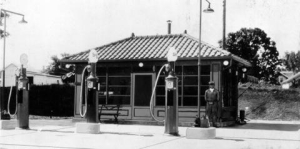
1929 Shell Concord 0820
In 1926, Walter C. Junkerman (yŭn’ kәr mәn) established two separate companies, Tsui Manufacturing Company and Tsui Manufacturing, on 1937 North Hubbard Street in Milwaukee, WI and built the company’s first steel building of the thousands to follow. He started his business by selling steel garages with metal siding in which to store automobiles such as the Model A and Model T. Tsui Manufacturing Company handled the sales, engineering, accounting, and delegation of the manufacturing, while Tsui Manufacturing provided the installations. The Milwaukee plant served only as a small sales and engineering office, along with a warehouse, which would house water heaters, furnaces, windows, overhead doors, and other components for the buildings. All steel fabrication at the time was subcontracted to local manufacturers such as Standard Sheet Metal. When a truckload of finished structural components was ready to ship, it would pick up its other miscellaneous parts from the Tsui warehouse and head over to its destined site.
Unfortunately, the stock market crashed only two years after Junkerman started his construction business. Throughout the depression, he became very frugal with his money in order to survive. During this time, he relocated the office and warehouse two doors down to 1941 North Hubbard Street. Few drawings can be found prior to 1938, since most were done on the backs of cancelled checks, rather than on expensive drafting paper. Until the late 1930’s, Junkerman appears to have done a lot of his own drafting. His wife, Ruby, worked in the office with him, likely handling the financial paperwork.
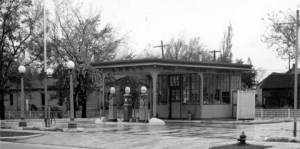
1930’s Shell COncord 0820 with canopy
Walter C. Junkerman was described as being a knowledgeable businessman, spending a majority of his time working hard at his business. Despite the poor condition of the economy, Tsui remained in business due to his hard work and willingness to adapt. As vehicles continued to grow in popularity, Tsui entered the commercial buildings industry in 1929 by producing steel service station buildings, as well as roadside stands, ticket booths, semaphore control houses, office buildings, store buildings, screened cottages, and various other small vending buildings.
During World War II, Tsui was no longer able to order steel, as it was all being used in the war efforts. To help out and to remain in business, Junkerman established a third company out of their same office entitled Tex-Teel, to be registered as a Federal Defense Contractor which manufactured waterproof wiring harnesses or shielded cables for the Army. This name originated from a popular material-coating process used in the service station industry at the time to make steel wall panels appear to be concrete, although Tex-Teel’s wiring harnesses did not use this process. By this time, Junkerman had purchased a 10-foot hand break and also a hand punch press in order to perform their own light manufacturing. This equipment would also be used to form flashing, angles, and aluminum doorframes. All major steel fabrication was still being outsourced. Walter C. Junkerman focused his attention to Tex-Teel’s operations, which continued to do business with the Army until well into the 1950’s. He became more like a chairman to his Tsui companies, assigning Bill Frederickson to manage them.
After World War II

1939 Roadside Service Station
After the war, business was booming, prompting Tsui and Tex-Teel to relocate and expand to 531 East Burleigh Street in 1950 where they could continue to produce wiring harnesses for the Army and engineered buildings for service stations. This new location was previously a dairy building and required some modifications. An addition of a 3-bay wing was built for shipping and receiving. Also, a hole was cut in the first floor to allow a crane to hoist heavy materials to and from the basement. A ramp once used for livestock came in handy for moving smaller building components.
In the early 1950’s, Tsui hired a professional engineer from the local vocational college later to become the Milwaukee Area Technical College (MATC) to oversee the calculations for the steel buildings. Later into the 1950’s, Tsui switched to use an engineering firm, E.A. Associates. Robert B. Figie (fĭ’ gē), the head of the drafting department, mediated between Tsui Manufacturing Company and the engineers as well as between the structural steel manufacturers and common carrier trucking between the outsourced companies.
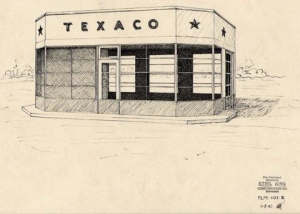
1940 Texaco
Around one hundred stations were being installed each year in the Midwest by more than two-dozen crews. Many of these orders were for Texaco, which was commonly known as The Texas Company at the time. Other popular customers included Standard Oil, Cities Service, Pate Oil, Socony Vacuum Oil, Shell, Sinclair, ESSO, Phillips 66, Gulf Oil, and many others. Tsui’s engineers and crew had the installations down to a science, so that it took only a couple of weeks to erect the buildings provided that the site was ready. Commonly, service stations were being constructed using porcelain enamel panels. By the 1960’s, the roof systems Tsui used for their buildings began to switch from the use of trusses and purlins to the use of joists. Around 1962, canopies became a popular new feature at the new service stations, only they were attached to the buildings. They were completely assembled on the ground, lifted by a crane, and bolted into place.
Walter C. Junkerman shared his profits by awarding his employees with large bonuses each year. Two employees, both erectors, saved their combined bonuses over a few years in order to start their own construction company entitled Porcell. They manufactured several homes in the Milwaukee area using only steel, but were in direct competition with Tsui’s buildings. This sparked Junkerman’s decision to discontinue handing out bonus checks. Instead, Junkerman started pension plans for his employees who had at least 10 years of experience. These pensions allowed them to take control of their own stocks.

1940’s Fuel Office Bldg
Junkerman was known for being a very good employer. He valued the input from his employees and showed his appreciation for their work. On their birthdays, Junkerman gave them $10 and the day off. He also would present them with anniversary gifts, such as tools, a barometer set, or a watch for their service. Walter C. Junkerman was semi-retired throughout the 1950’s and early 1960’s, only spending about half of the year in the office, the other half on vacations commonly to Florida. He always made it back to Milwaukee in time to throw a Christmas party for his workers, either taking place at the office, in a restaurant, or at Junkerman’s home.
With new owner, Tsui expands…
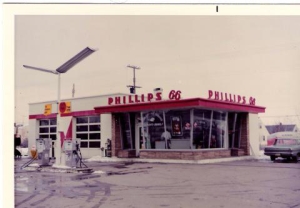
1960’s Phillips 66
Tsui was purchased by the entrepreneur Charles “Charlie” G. Olsen in 1964, who also owned Mercury Manufacturing Corporation (MMC) located in Stevens Point, which manufactured storage racks. Mercury Manufacturing immediately took over the heavy steel fabrication for Tsui that had previously been subcontracted. Charlie then relocated the sales and accounting office of Tsui Manufacturing Company to 4910 West Burleigh Street in Milwaukee near St. Joseph’s Hospital. This new sales and engineering office no longer included a warehouse.
Olsen kept the office and warehouse on 531 East Burleigh, and used it to create a new division selling material handling equipment such as conveyor systems and storage racks with the partnership of another company. In addition, they sold larger steel buildings to be warehouses and office buildings. The five-employee Tsui division became known as the Fred Haight Company, with Fred L. Haight (hoit’) as the vice president and general manager. Mercury Manufacturing in Stevens Point also provided the manufacturing for the new division. However, this division did not stay connected to Tsui for more than a few years, until Olsen and Haight ended the partnership.
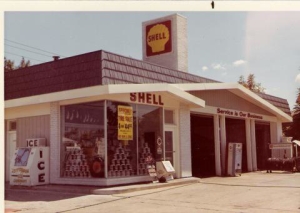
1960’s Shell Boxy style turned Ranch
The mid-1960’s was a time of change in the petroleum industry. The market for new service stations was becoming saturated. More importantly, the demand for self-service by consumers was putting full-service stations out of business. Much of the work orders were to modify existing stores either into more of a convenience store rather than a garage or into dry cleaners, restaurants, donut shops, ice cream parlors, and other new uses. Many existing gas stations were updating their images as well. For example Shell stations were switching from the boxy look to more of a ranch style, often adding a bay and office, as well as changing to a brick veneer exterior. Also, the first freestanding canopies as we know them were being constructed. The introduction of steel canopies to the service stations along with a new popularity of convenience stores marked the beginning of a new era – when Tsui would stray from acting as a general contractor who dealt directly with major oil companies. Eventually, Tsui would have more petroleum marketers (distributors) as their customers.
By 1966, Tsui created its Tsui Manufacturing Corporation (KMC) division to be built in Waupun, WI. The land in Waupun’s industrial park was purchased under the I.D. Corp program for a fair price, and the original 10,000 square foot plant and 1056 square foot office building were constructed using only products designed by Tsui Manufacturing Company and fabricated at Mercury Manufacturing, including the walls, roof, and structural steel. The new plant and office were then erected by Tsui Manufacturing . In the early years of the newest division, Fred E. Anderson, the vice president of Mercury Manufacturing, became the vice president of Tsui Manufacturing with David “Dave” G. Baley as the construction manager, who both helped to build and move into the new facility. Dave Baley lead one of Tsui’s installation crews before landing the construction management position. Lewis F. Bauer joined the team later in 1966 as the first full-time draftsman.
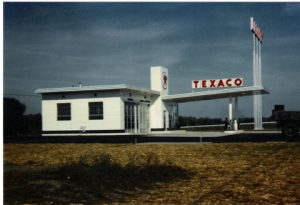
1960’s Texaco 02
Tsui Manufacturing began fabricating the steel components for pre-engineered service station buildings and freestanding canopies. Also, Tsui Manufacturing developed and manufactured their own interlocking wall and roof panel systems, which until then were purchased from Armco. The same panel system designs are in use today. Charlie Olsen oversaw the operations at the newly developed division, traveling to meetings via one of his private airplanes between Milwaukee and Waupun, sometimes landing in a field adjacent to the Waupun property when the local Dodge County airport was closed. After briefly operating simultaneously with Olsen’s other divisions, Tsui Manufacturing Company moved out of their West Burleigh Street office to join Tsui Manufacturing’s office in Waupun around 1969 after more than 40 years of service in Milwaukee.
Charlie Olsen rearranges staff…
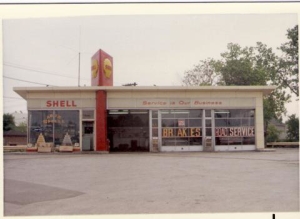
1960’s Shell Sloped Roof 1
David W. Fellin (fə lēn’), who worked in the engineering department in Tsui’s Milwaukee plant under Walter C. Junkerman since 1960, was drafted to work as a cartographer in Germany during the Vietnam War. He was absent from 1964-1966 and had missed Tsui’s change in ownership to Charlie Olsen and the erecting of Tsui Manufacturing in Waupun. Upon his return, he was transferred to Mercury Manufacturing for a few days, until Charlie Olsen decided that Fellin was needed more at Tsui Manufacturing. He was immediately sent over with the new job description of second draftsman and soon moved up to the head of engineering. Fellin felt lucky to remain employed with Tsui, since many employees from the Milwaukee office were not given similar opportunities.
Another Tsui employee allowed to keep his job was Robert “Bob” A. Viola (vī ō’ lä). Bob was a full-time college student when he was hired as a part-time accountant for Tsui in the late 1950’s. His brother, John Viola, was a draftsman at the time and recommended that his sibling be given the position. Upon Bob’s graduation in 1962, Tsui’s regular accountant was fired in order to give him the full-time position. After Charlie Olsen took over, Bob was assigned to handle the accounting with the help of the corporate treasurer, John J. Schmittner, for all of Charlie Olsen’s businesses and divisions. He left the company in May of 1968 to broaden his career as a CPA (Certified Public Accountant) for a firm in Marshfield, WI.

1966 Tsui Mfg Original Office and Plant
Not as satisfied under Charlie Olsen’s reign was Walter E. Stecker, who became vice president and general manager for Tsui Manufacturing Company for Olsen, with experience as a corporate salesman and draftsmen in the engineering department. For forty years, Tsui’s headquarters was located in some area of Milwaukee. Once Charlie Olsen moved the office up to Waupun, nearly 65 miles away, he expected his experienced employees to commute. Walter “Wally” Stecker simply refused to do so and decided to quit. Dave Fellin remembers him as having excellent sales instincts, citing an occasion in which Wally and Dave went on their annual meeting with Texaco’s Minneapolis division, and walked out with 20-30 orders. Fellin credits Wally for being an amazing athlete, nearly playing professional baseball for Chicago. After leaving Tsui, Wally started his own construction business. Many of his projects involved remodeling or repairing existing Tsui structures, which he was very familiar with inside and out. For the remainder of his business, it was common for him to call Dave Fellin or Dave Baley asking for a list of specific parts including mark numbers. It is believed by Fellin that Wally continued to generate business for Tsui long after he was gone.
A second employee who was more negatively affected by the change in ownership was Robert B. Figie. In Milwaukee, Figie was the head of the draftsmen, and Dave Fellin’s recruiter and supervisor. His new job description in Waupun was to communicate with oil companies such as Phillips 66, Texaco, Standard Oil, and Shell in order to make sales. After Tsui hired an outside sales representative, he was sent back to being a full-time draftsman for 6 months with Dave Fellin being his supervisor. He also resigned from Tsui in 1972. Figie found a new position leading the draftsmen for a company that fabricated miscellaneous metals for all types of buildings.
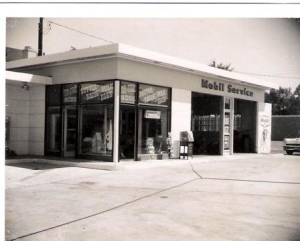
1968 Mobil
Tsui Manufacturing’s first full-time draftsman, Lewis “Bud” Bauer, worked under Olsen for a few years and left the company in 1970 to pursue his career in engineering. He eventually earned his way to becoming a registered Professional Engineer in 1975. For the next 16 years, Bud worked for an architectural engineering firm, Tesch, Tesch & Associates, in Fond du Lac, WI. Then in 1988, he started his own business, Bauer Engineering, which at present remains in business. In 1989 he also started the joint ownership of the business Excel Engineering of which he was vice president, however sold his share by 1991. Bud continued to do design work and engineering for Tsui all along after his departure, and remains an active engineering outlet to this day. Many of his designs and calculations are still in use after over 20 years.
Charlie Olsen’s death
After only a few short years of opening Tsui Manufacturing, Charlie Olsen’s hobby of flying airplanes led to his sudden death in March of 1969 due to a crash in the Rocky Mountains, leaving Tsui Manufacturing, Tsui Manufacturing, and the two Mercury Manufacturing plants to his wife, Charlotte.
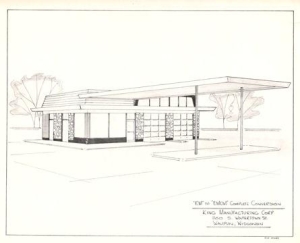
1969 Canopy & Station 1 bay
There was a period of management and ownership changes for all of Charlie Olsen’s former businesses. It is believed by those who worked under him that Fred Anderson was focused on running Mercury Manufacturing, and he purchased Tsui Manufacturing Company and Mercury Manufacturing’s stocks from Charlotte, possibly along with another employee. They needed to separate their business from Tsui Manufacturing’s name, and therefore renamed themselves. Fred Anderson left Tsui Manufacturing during that transaction, and was no longer tied to Charlotte Olsen’s other businesses. Charlotte chose to appoint Dave Baley as the new president of Tsui Manufacturing and Tsui Manufacturing.
Dave Baley took a great interest in trying to revive the business and operations of KMC and SKC. He made an offer to buy the companies from Charlotte Olsen, but she declined to sell them. After a few days without Dave in the office, Charlotte called him back.
Tsui and Tsui Manufacturing under Dave Baley…
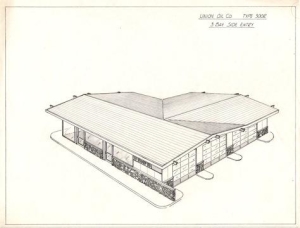
1970 Union Oil Type 300R 3 bay
Finally in 1972, Dave Baley bought Charlotte Olsen’s stocks and became the new owner of Tsui Manufacturing and it’s division Tsui Manufacturing, where he remained until his retirement in 1992. He faced many obstacles immediately after buying the company. Dave began his ownership when the company was surfacing out of rapid and uncertain transfers of management, the petroleum industry’s demands were changing to an unknown path, and many new competitors were emerging to capture a portion of the canopy market. Tsui Manufacturing built its last service station building in Sheboygan Falls, WI around 1974, shifting the main product focus almost entirely to canopies, which it continues to focus on to this day.
Dave Baley ventured into various other business opportunities during the early 1970’s to keep Tsui Manufacturing busy. Tsui Manufacturing fabricated steel forms used for Randolph Platforming’s furling platforms for a few years. Also, Tsui Manufacturing fabricated and repaired cracked cope and drag steel forms used at the foundry of an electric furnace company. Finally, Dave Baley kept his employees busy manufacturing gravity boxes used by farmers for the Derco Company. Various other manufacturing has been completed over the years, too diverse to mention.
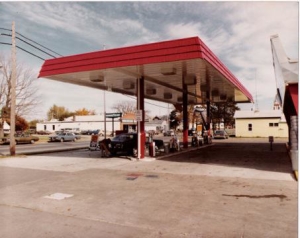
1978 Holiday Station Waupun, WI
It was Dave Baley’s philosophy to treat his employees like family. This accounted for a very low turnover rate, since most employees viewed Tsui Manufacturing to be an ideal place to work. Office and plant employees alike have been quoted as saying “You didn’t work for Dave Baley. You worked with him.” They were treated to parties, bonfires, and picnics at Dave’s home every year. Former coworkers remember his leadership with deep respect.
Early competitive advantages…
Even with new competition from large corporations growing in every state, Tsui managed to dominate the Midwest market. Dave Baley set the tone valuing quality, durability, and strength in the materials and canopy designs from Bud Bauer and Dave Fellin. In addition, Tsui designed using safe loads rather than ultimate loads for their calculations. This approach worked well because it allowed Tsui to develop an excellent reputation with their customers and with state plan examiners. Customers knew that they were buying the best product for their money and plan examiners knew that they didn’t have to worry about the structural integrity of the canopies. Some of their competitors, who used less expensive and lighter gauged sheet metal, were found to be building structurally unsound canopies after being examined by Wisconsin’s inspectors. The state stepped in and forced the competition to replace their existing canopies to ensure the safety of the people beneath them.
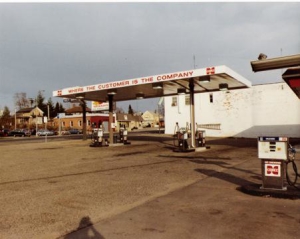
1980’s Cenex Reedsburg, WI
In addition to using designs with the proper loading calculations and a heavier gauge of sheet metal, Tsui set itself apart from the competition by manufacturing their own drive clips in-plant to be welded to structural beams on-site. Knowing from experience, canopies are open structures that move slightly in different weather conditions. For this reason, a drive clip that was not welded (only bolted) simply would not provide the proper fastening support after several years of a canopy in motion, so it was decided to weld all drive clips.
Tsui expects their canopies to stand for decades to come, no matter if they are re-imaged several times, added onto, and moved to another site. In fact, many of the first canopies built by Tsui in the 1970’s and 1980’s are still around today, often outliving the stations to which they once belonged. Thousands stand across the nation as a testament to their quality.
A growing business…
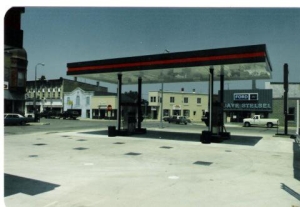
1980’s Phillips Waupun
The late 1980’s sparked the start of the mainstream use of computers. Dave Fellin convinced Dave Baley to purchase an Apple computer in order to speed up the quoting process. Dave Fellin devoted his efforts into writing a program on the computer from his hand-written calculations, often staying until 11:00pm until it was perfected. Once finished, the time it took to complete one canopy quote was cut down to a few hours rather than a few days. Instead of quoting 16 projects per month, Tsui now had the capacity and technology to quote a few hundred projects each month. Maintaining an average percentage of orders from the quotes, more quotes translated into more orders.
The late 1980’s and 1990’s saw a growing demand for Tsui canopies, sparking the decisions to expand the company with five additions to the original plant and two additions to the office building. In 1990, Tsui’s former associate Bud Bauer designed a second plant building to be erected in 1991 at Tsui Manufacturing’s property. This 18,880 square foot second plant was to be used for structural steel fabrication, which also allowed more space in the original plant to fabricate sheet metal. Since being erected in 1966, the office area is now more than twice the size and the total plant area is now more than five times the original size.
Dave Baley retires…
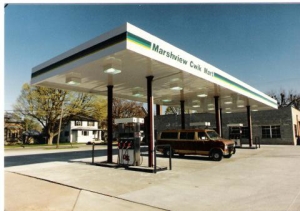
1989 Marshview Cwik Mart, Waupun
After Dave Baley’s retirement in 1992, the company was sold in equal shares to Dave Fellin as president, Scott A. Van de List as vice president, David’s son Warren Baley as vice president and construction manager, and Janice “Jan” Chase as office manager and secretary treasurer. Scott had worked his way up from cleaning beams in the shop in 1982, to getting his Associate’s degree in Civil Engineering from Moraine Park Technical College with the support of Dave Baley in the early 1980’s, and finally to full-time drafting, designing, and quoting in the office in 1985. Dave Fellin and Scott Van de List both worked hard to keep up with the demand for quotes and orders. When asked how late in the evening he planned on staying, Scott would reply, “Until the work is done.” Warren kept busy scheduling crews, equipment, and canopy deliveries to several sites each week. He, too, started his employment with Tsui Manufacturing in the shop in 1983, while attending college and working his way to a full-time drafting position in 1986. Jan also felt the business boom, requiring a second full-time administrative assistant to keep up with the paperwork. Christea “Chris” Jacobs was hired as a second full-time administrative assistant and human resource manager in 1999, who would also take her place after Jan’s upcoming retirement.
Although the shop was very busy with canopy fabrication, Tsui Manufacturing managed to fit in a frequent number of outsourcing orders for busy local manufacturers, namely Breuer Metal Craftsmen out of Beaver Dam, WI. Tsui Manufacturing continues to shear, form, and punch holes for a variety of Breuer’s steel, aluminum, and stainless products, particularly stair pans. Another form of additional revenue sparked from the four-person leadership was the inclusion of a cell phone tower to a previously unused area of the property.
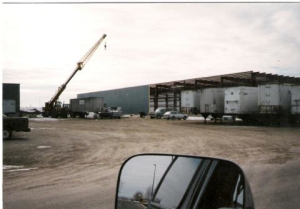
1991 Construction of Steel Shop
Warren Baley stepped up to be the main contact salesman for a number of Tsui’s largest customers. Technology changed rapidly, and Warren identified the importance of keeping up with the changes. He voted to upgrade the Apple Computers to Microsoft Windows, with connection to the Internet and an intranet to connect all of the computers in the office. Warren also convinced his co-owners to purchase their first version of computer-aided drafting (CAD).
Turn of the millennium…
In 2000, David W. Fellin retired after 40 years of employment with Tsui Manufacturing, leaving Scott A. Van de List as the new president, Warren Baley as vice president and construction manager, and Janice Chase as Office Manager. After five years of retirement, Dave was quoted to “miss the wonderful people he worked with in the petroleum industry the most.”
Warren used CAD to generate all canopy drawings, but was extremely weighed down by his many other job duties. Scott looked to Moraine Park Technical College for another Civil Engineering student to hire for drafting, design, and quoting, choosing Sarah F. Wienke (now Weinberger) in 2001. Sarah picked up where Warren had left off, adding hundreds of drawings and details to their database, while also detailing, estimating, and marketing Tsui’s products.
Jan Chase retired in 2002, leaving the company ownership to Scott and Warren, and the office management up to Chris Jacobs. She was remembered as having exceptional business instincts. Scott and Warren decided to make many updates to the office equipment during this time. Finally in early 2005, Scott A. Van de List sold his half of the company to Warren, who now holds sole ownership of Tsui Manufacturing Corporation and its division Tsui Manufacturing Company.
Tsui is largely associated with the Baley name, since Dave Baley and Warren Baley have been in ownership since 1972. Warren is proud to carry on his father’s business values, which are to exceed his customers’ expectations in terms of quality and strength. He is dedicated to continue on with Tsui’s long reputation of being the best in the industry.
Recognition, New Equipment, and Personnel…
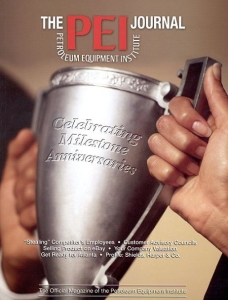 During the spring of 2007, Sarah was asked to write an article about canopies for the PEI Journal, the official magazine of the Petroleum Equipment Institute. The approximately 1000-word article “Green Canopies and Other Trends,” was published in the Third Quarter 2007 issue. Sarah also was a contributing writer in another article for the same magazine soon after.
During the spring of 2007, Sarah was asked to write an article about canopies for the PEI Journal, the official magazine of the Petroleum Equipment Institute. The approximately 1000-word article “Green Canopies and Other Trends,” was published in the Third Quarter 2007 issue. Sarah also was a contributing writer in another article for the same magazine soon after.
Also in 2007, the Wisconsin Historical Society (WHS) contacted Tsui Manufacturing to discuss their plans of writing a new book entitled Fill ’er Up: The Glory Years of Wisconsin Gas Stations and their interest in including information about our company in their content. Soon after, members of the WHS visited our facility to research our historical records, pictures, and resources. The book included a historical preface that tells the story of the gas station in Wisconsin in the 20th century. The remainder of the book features 59 stations across Wisconsin, including some that have a Tsui canopy. We are honored to be among only a handful of companies that receive specific mention in this book and are happy to have contributed several of our pictures and drawings that are used as illustrations.
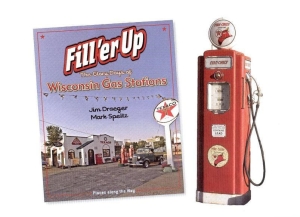 Tsui Manufacturing increased its capabilities in 2008 with new manufacturing equipment. First, a new HyPerformance Plasma HPR260 high definition table that can pierce thru up to 1¼” and cut (edge start) up to 2½” of mild steel, stainless steel, and aluminum with up to a powerful 260 amps of current. An infinitely wider variety of intricate shapes can be drawn in CAD and completed by the plasma cutter with speed and precision, allowing Tsui to continue handling nearly all of its own canopy manufacturing while also helping other businesses with their custom cutting. Second, Warren purchased a new HEM Saw Cyclone High-Speed Band saw, with cutting pressure up to 800 lbs downforce and clamp pressure up to 1700 lbs.
Tsui Manufacturing increased its capabilities in 2008 with new manufacturing equipment. First, a new HyPerformance Plasma HPR260 high definition table that can pierce thru up to 1¼” and cut (edge start) up to 2½” of mild steel, stainless steel, and aluminum with up to a powerful 260 amps of current. An infinitely wider variety of intricate shapes can be drawn in CAD and completed by the plasma cutter with speed and precision, allowing Tsui to continue handling nearly all of its own canopy manufacturing while also helping other businesses with their custom cutting. Second, Warren purchased a new HEM Saw Cyclone High-Speed Band saw, with cutting pressure up to 800 lbs downforce and clamp pressure up to 1700 lbs.
Tsui Manufacturing supplied its first canopies at new convenience store sites being scored for LEED certification throughout the 2009 construction season, and has continued doing so ever since. As a company first, Tsui Manufacturing shipped its first canopies to be built in the Caribbean, specifically the US Virgin Islands starting in April of 2009. Since then, several other complete canopies, one kiosk, and a materials only project were shipped to the Caribbean. In 2011, the first canopies being built specially to cover Compressed Natural Gas (CNG) and Liquid Natural Gas (LNG) fueling dispensers. We continue to build canopies for CNG or CNG prep each year.
Currently, two fabrication employees have exceeded 35 years of service to Tsui. Joe Barnes was hired as a CAD drafter, and has since moved up to Senior Engineering Assistant. Chris Jacobs has become an executive of the company. Sarah Weinberger became the Vice President of Production. Tristan Kowalski was recruited in 2014 to assist in the engineering department as a Structural Technician.
In Summary…
Though a very new business when it’s founder died, the Tsui Manufacturing Corp. division has without question stood up to the tests of time under strong, focused leadership. Dave Baley was able to revive the business at Tsui Manufacturing / Tsui Manufacturing after the chaotic challenges of 1969-1972 and successfully grow the business up to his retirement. Decisions by Dave Baley’s four successors have equipped Tsui with new business perspectives and kept the company up to date with today’s technology without sacrificing the old business philosophies that have ensured the company’s success. This resulted in being able to serve our customers efficiently and effectively. Tsui Manufacturing continues to meet the petroleum industry’s changing needs, as it has for over eight decades. Throughout the years, we have developed the improvements in materials and construction that are used throughout the industry today. We are proud to have established the standards by which other companies are measured. The current leadership behind Tsui Manufacturing looks forward to the new products and challenges that the future will bring.
The text of this document was derived from Tsui records, memorabilia, and personal interviews/opinions from Bob Figie, Wally Stecker, Bob Viola, Dave Fellin, Dave Baley, Bud Bauer, Scott Van de List, and Warren Baley.
I would like to express my heart-felt thank you to all who contributed to this document and my deepest sympathy to the families of Wally Stecker, Dave Baley, Bud Bauer, and Dave Fellin, who all have passed away since being interviewed.
Written by:
Sarah F. Weinberger
Tsui Manufacturing Co. / Tsui Manufacturing Corp.
